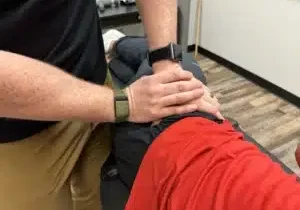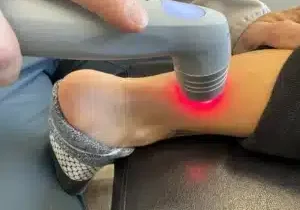How to safely transition from your day job to your active hobbies.
We all know that sitting most of the day is unhealthy in some big ways, but most of us can’t change our work conditions. Counteracting our sedentary daytime with high levels of activity outside the workplace is a good idea, with a few considerations.
The actual transition from the desk to the gym is an important time. Muscles are not ready to jump up and start running or lifting heavy things right away. They need a safe transition. You can do yourself a lot of harm by not taking this critical piece seriously. However, it can be a huge asset in undoing the negative effects of sitting if it is done correctly.
The Hard Truth
When you sit all day your muscles and tissues adjust to this position in unhealthy ways:
- Over-shortening
- Over-stretching
- Tightening
- Reduced activation
- Reduced muscle tone
Too much sitting can also contribute to a vast number of musculoskeletal issues including:
- Bulging discs
- Low back pain
- Headaches
- Tennis elbow
- Achilles tendonosis
- Carpal tunnel
- Neck pain
Even if you leave your sedentary job and go workout hard, you can still develop these issues. Yup, that’s right. Hard exercise does not counteract all the negative effects of sitting. It’s like eating a doughnut and spinach: as much as the spinach is full of nutrients your body needs, you are not undoing the fried fat of the doughnut.
Sitting Creates Muscular Imbalances
Your body is designed to adjust to current living conditions in order to conserve energy and maintain homeostasis (the stability of all physiological body processes). When you sit for long periods of time the body begins to form a sort of new “normal.” Your hip flexors are in a significantly shortened position, your hamstrings and glutes are at a full stretch, your pecs and biceps are short, your upper back muscles (really, all your back muscles) are in a full stretch, and your Achilles are mostly pulled tight. Then you get up and walk to the gym where you push heavy things, run long distances, and cycle until your quads give out. Everything is hunky-dory.
Nope.
When your body has adjusted to this seated lifestyle those tissues remain in this new state when you stand up. Shortened tissues stay short, stretched tissues stay elongated. This creates what we call muscular imbalances; some muscles will not work as well because they are too short / too long / too weak. When you move, the stronger and shorter muscles will pull more than the weak and elongated ones. Boom! You end up with tendonosis from overused biceps, spinal degeneration from weak back muscles, and sciatica from underutilized glutes.
Stretch Breaks
If you are not one of the lucky few who get a job of constant variation (if you think that’s you Mr. Construction Man, think again) you can do some basic movements to bridge the gap into your workout. Taking 5-minute breaks every hour is ideal, but you can bundle 3 of these into a 15-minute break every couple of hours.
Worried that your boss won’t like seeing you take so many breaks? Studies show that small breaks every hour create higher productivity overall. Good for the body, good for the mind.
Joint Mobility
Performing 10 minutes of focused joint mobility is a great way to prime your body for movement and prepare your joints for load.
Warm-Up No Matter What
When you get done at your desk job and are ready for your workout, DO NOT SKIP THE WARM-UP.
Your warm-up can include the light-intensity versions of your activity (body weight squats, light jogging, etc.). An even better option is a functional warm-up (lunges, karaoke, push-ups, supermans, butt kickers, etc.). These movements include multiple joints and a larger range of motion than you have been doing throughout the day.
You should break a sweat during your warm-up. Don’t worry, it won’t “wear you out,” on the contrary your muscles will be primed to perform.
Be Strategic
Every exercise that you half-mindedly walked through during middle school PE and track has a solid intellectual base backing it. You’re not a middle school kid anymore so you need to tailor your warm-up a bit better.
If you are planning a light workout, a shorter warm-up may suffice. However, if you’re planning on moving some big, heavy weights, pushing the mileage, or setting some new PRs, your warm-up needs to be longer with a steady increase of intensity. Start with slower, more controlled movements like walking lunges and knee hugs, progress to more whole-body exercises, such as burpees, then finish with fast-paced and explosive things like high knees and jump squats. If you’re lifting weights, don’t skip those lower % higher rep rounds; those are the warm-up rounds that get your nervous system primed and muscles flexible enough to go big. All the research says that skipping these decreases performance. Period.
Injury prevention specialists
Our team are experts at helping you heal from injury, and we are passionate about protecting from getting hurt in the first place. We can evaluate how you are currently moving, and teach warm-ups and stretches personalized for your individual needs. Call us at (425) 776-2936 or visit our New Patients page to learn more.
How Manual Therapy Can Be Your Key to Pain Alleviation and Overall Wellness
Discover the transformative power of manual therapy for pain alleviation and wellness in our blog ‘How Manual Therapy Can Be Your Key to Pain Alleviation and Overall Wellness’.
Read MoreThe Role of Chiropractic Care in Sports Injury Rehab: A Deep Dive
Explore the essential role of chiropractic care in sports injury rehab in our comprehensive blog ‘The Role of Chiropractic Care in Sports Injury Rehab: A Deep Dive’.
Read MoreHow Your Local Chiropractor Can Help You With Back and Neck Pain
Understanding back and neck pain Back and neck pain can be caused by poor posture, muscle strain, injury, or underlying health conditions. The pain may range from mild to severe and can affect your daily activities. Common symptoms include stiffness, muscle spasms, and limited range of motion. In some cases, the pain may radiate to…
Read MoreRehabilitation Services for Sports Injuries: A Comprehensive Guide
Understanding sports injuries and the need for rehabilitation services Injuries during sports are common and can affect athletes of all levels. Rehabilitation services play a crucial role in helping athletes recover from these injuries and get back to their peak performance. With the right guidance and treatment, athletes can regain strength, flexibility, and mobility, ultimately…
Read MoreUnderstanding Posture Therapy: Techniques and Benefits
What is posture therapy? Posture therapy involves exercises and techniques to improve your body alignment and position. It aims to correct postural imbalances and relieve pain and discomfort caused by poor posture. The therapy focuses on strengthening muscles and stretching tight areas to achieve proper alignment of the body. It can also include education on…
Read MoreThe Science Behind Foot Pain Therapy: Understanding the Basics
What causes foot pain? The most common cause of foot pain is wearing ill-fitting or unsupportive footwear. High heels and narrow toe boxes can put excessive pressure on the feet, leading to issues like bunions and corns. Flat feet or high arches can also contribute to foot pain because they affect the alignment and distribution…
Read More





